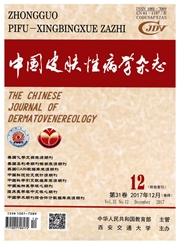

 中文摘要:
中文摘要:
目的观察中波紫外线(UVB)辐射后成纤维细胞(FB)DNA光产物环丁烷嘧啶二聚体(CPDs)产生和清除情况及表没食子儿茶素没食子酸酯(EGCG)和黄芩甙的干预作用。方法以30,60,90mJ/cm^2B照射FB并予EGCG及黄芩甙干预处理,采用免疫细胞化学法在照光后不同时间检测CPDs的产生和清除情况。结果细胞损伤程度随照光剂量加大而加重;30mJ/cm^2UVB照射后细胞CPDs生成量在辐射后1h左右达到高峰,同时细胞也开始清除CP-Ds,辐射后4h内清除速率较快,4h后清除速率逐渐降低,至24h基本清除CPDs;EGCG和黄芩甙处理UVB辐射的细胞CPDs少于单纯照光组(P〈0.05)。结论UVB辐射可以导致FB的DNA损伤而产生光产物CPDs;细胞损伤程度显示剂量依赖性;细胞自身有修复能力;EGCG和黄芩甙均可降低UVB辐射所致的光产物水平。
 英文摘要:
英文摘要:
Objective To investigate the production and removal of cyclobutane pyrimidine dimers (CPDs) induced by UVB irradiation and intervention effect by epigallocatechingallate (EGCG) in human fibroblasts. Methods Fibroblasts were irradiated only by UVB or treated with EGCG or baicalin. The production and removal of CPDs at different time intervals were examined by immunohistochemical method. Results The damage of fibroblasts was increased in the dosage of UVB irradiation. CPDs appeared in fibroblasts and reached the peak in 1 h and removed rapidly during the first 4 h and then removed slowly or almost cleared out up to 24 h after UVB irradiation. The quantity of CPDs was decreased when irradiated fibroblasts were incubated with EGCG or baicalin (P 〈 〈 0.05 ). Condusion UVB irradiation induced the production of CPDs ; the photodamage of fibroblasts was UVB dose dependent; DNA lesions could be repaired by cell itself;EGCG and baicalin could decrease the level of CPDs.
 同期刊论文项目
同期刊论文项目
 同项目期刊论文
同项目期刊论文
 期刊信息
期刊信息
